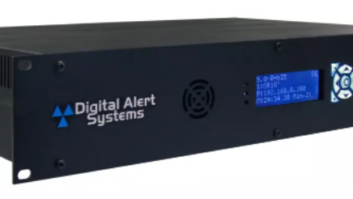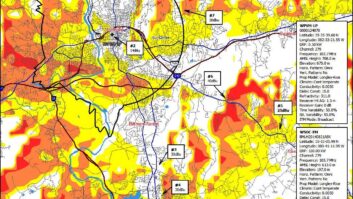(click thumbnail)HD Radio Bandwidth in a 9 kHz Steps EnvironmentAs digital radio is implemented around the world, broadcasters face a key decision: Which digital radio system is right for my country? The answer to that question is complex and encompasses many technical, regulatory, financial and political issues.
This paper does not aim to solve the question, but to examine one facet: the way existing band plans and allocation tables in the current AM and FM bands lend themselves to various technologies.
By limiting the scope of this paper to digital systems that operate within the existing AM and FM bands we do not discount DAB, DMB, DVB-T, DVB-H and ISDB-TSB, which require additional spectrum to be allocated. In fact, these technologies are not mutually exclusive to systems that operate within the existing AM and FM bands, and should a country implement one of these systems they still will be faced with the question of whether and how to digitize the stations within the AM and FM bands.
AM IN-BAND SYSTEMS
There are two systems available for AM digital radio use: Digital Radio Mondiale (DRM) and HD Radio. While there are profound differences between them in bandwidth requirements and flexibility, they both are Orthogonal Frequency Division Multiplex (OFDM) systems, which use a number of sidebands to carry the digital information.
DRM as it exists today is designed primarily as a long-wave/medium-wave/shortwave system and has considerable flexibility in how it may be configured to meet various bandwidth, payload and robustness criteria. The DRM Broadcasters’ User Manual, downloadable from www.drm.org, is a wealth of information about the various options that DRM makes possible.
Where the channel steps are 9 kHz, such as anywhere outside the Americas, DRM is normally installed with a 9 kHz bandwidth (carrier +/- 4.5 kHz) on a single channel, or 18 kHz bandwidth (carrier +/- 9 kHz), which utilizes one channel plus half of the two adjacents.
(click thumbnail)Cap: Manila AM Frequency AnalysisThere are options for using adjacent channels for an analog AM broadcast, but this isn’t in common use, as some tests have indicated that the analog signal must be greater than 16 dB above the DRM field strength at the receiver to avoid interference from the DRM signal into the analog receiver.
There also are proposals to implement a SSB AM signal and use the other half of the channel bandwidth (formerly occupied by the other sideband) for DRM. But this is predicated on synchronous detection of the AM signal, and in general, shortwave receivers are much more likely to feature synchronous detectors than are AM radios.
The other AM in-band digital radio solution is HD Radio, which was developed to meet the unique needs of the U.S. broadcast market and is based on the 10 kHz AM channel spacing found in North and South America. In the United States the AM band is full of stations and there aren’t a lot of open frequencies to put a stand-alone digital signal.
On the other hand, adjacent frequencies are not normally allocated within the same area, so HD Radio was designed to keep the AM analog signal essentially unchanged (just band-limited to 5 kHz audio response), and to utilize the spectrum beneath the analog signal, plus on the two adjacent channels for OFDM sidebands to pass the digital component.
HD Radio fits the needs of U.S. broadcasters because it allows full simulcast of the legacy analog signal as well as the new digital signal. Eventually, when digital receivers make up enough of the receiver installed base, the analog signal may be shut down and the HD Radio signal will be reduced in bandwidth to +/-9.6 kHz.
(click thumbnail)Frequency Chart DZXL — RMN — ManilaHD Radio reduces the effect of digital-to-analog on-channel interference because the sidebands above the carrier frequency are out of phase to those below the carrier frequency, and are identical, thus they cancel in the analog receiver. While this is helpful for the on-channel signal, it does not eliminate the interference to adjacent channels.
There is no question that HD Radio can create significant interference to co-channel and adjacent-channel signals and, depending on the IF bandwidth of the receiver, on the second-adjacent signals as well. This has the effect of reducing the secondary coverage areas for a number of AM stations — in some cases, dramatically.
MARKET CONSIDERATIONS INFLUENCE DIGITAL
The choice of the optimal AM system in a particular area can be greatly affected by the radio channel allocation scheme in existence in a particular region. If the channel spacing in a country is 9 kHz, and there are free channels available for allocation, it is a simple matter to implement DRM.
Many European countries fall into this category, as reduced AM listenership has resulted in some AM stations being taken off the air — and these “dark” facilities may easily be re-purposed for DRM.
In some cases, however, HD Radio has been implemented successfully for market reasons. In Surabaya, Indonesia, in 2006, a religious broadcaster bought three adjacent AM channels and installed an HD Radio AM station on the center frequency.
He broadcast the same programming on the analog and digital transmissions, and used the analog channel to promote the purchase of HD Radio receivers, some of which are made in Indonesia. In this way, they provided higher-quality audio programming to their loyal listenership, while having just one transmitter, one antenna and paying a much less expensive license fee from the government than an FM station would have cost.
Fig. 1 shows how a standard HD Radio AM signal fits into a 9 kHz spacing band. Where the AM band is fully utilized, and spare channels are not available to construct new digital-only DRM channels, HD Radio is a possibility. An example is the Philippines, which like all of Asia, has AM channel steps of 9 kHz. Fig. 2 is a graphical analysis that presumes each station is running HD Radio in Manila, the most populous metropolitan area, and with the most crowded spectrum in the country.
As can be seen in Fig. 2, the channel spacing within the Metro Manila area is 36 kHz between stations and a guard band of 6 kHz exists between the AM HD sidebands.
(click thumbnail)Frequency Chart DZEC — Eagle — Manila
While Fig. 2 is compelling, there is additional analysis needed before any station is approved for use with HD Radio AM. As these are existing stations, co-channel interference to other stations on the same frequency has presumably been known for some time. With the HD sidebands extending to +/- 15 kHz from carrier, however, both of the first-adjacent channels will be impacted, and to a lesser extent, the second-adjacent channels also will be affected.
Fig. 3 is a graphical analysis of the physical locations of first- and second-adjacent stations in the Philippines relative to one 50 kW AM station.
As shown in Fig. 3, the nearest station on the first or second adjacent channels to 558 kHz in Manila is DZMQ, a 5 kW station on 576 kHz in Dagupan City, nearly 125 miles away from Manila. Summing the power in each of the AM HD Radio sidebands, which fall within the second-adjacent channel of DZMQ from 571.5 kHz to 573 kHz, totals approximately 375 watts — nearly 200 km distant, and is unlikely to create any interference to either DZXL or the second-adjacent stations.
A more serious problem exists with 1062 kHz; see Fig. 4. We see that there is a first-adjacent station, DZEL 5kW, in Lucena on 1053 kHz. This station, only 124 miles away from Manila, would receive nearly 1,130 watts from the HD Radio sidebands of 1062 kHz.
It is likely that some secondary coverage areas of DZEL would be affected, and conversely, HD Radio coverage of DZEC in the Lucena area could be affected. It is important to understand that the digital sidebands above the carrier and the mirror image ones below the carrier carry the exact same information, thus if interference garbles the ones below the carrier, the receiver can fully demodulate the program audio — with reduced robustness.
Adoption of digital radio in these circumstances is likely to compromise secondary coverage areas, but the tradeoff is that within the primary service areas the broadcaster is able to deliver dramatically improved audio performance, as well as text data.
In summary, both DRM and HD offer broadcasters an opportunity to transition the AM band to FM-like audio performance, plus adding opportunities for data services. While HD Radio is a hybrid system in which one station carries both the analog AM signal as well as the new digital signal, DRM typically replaces the analog station with a digital only signal.
(click thumbnail)Seoul FM Frequency AnalysisDRM excels in areas where the AM band has already died, and where the AM band is largely empty, while HD Radio may be the only choice where the AM band is fully utilized and there is no room for digital-only DRM stations.
FM IN-BAND SYSTEMS
There are three digital in-band systems, and they are dramatically different. HD Radio works a lot like the AM HD Radio system, with OFDM carriers on either side of the analog FM carrier so both the analog and digital signals are on a single FM channel. DRM+/DRM120, currently in development, are digital-only options, with the OFDM carriers occupying 96 or 100 kHz of FM spectrum.
FMeXtra utilizes OFDM carriers added to the composite baseband of a conventional FM analog signal, and thus the bandwidth of the FM signal does not appreciably change. Interestingly, FMeXtra may be operated on an existing FM HD Radio station, increasing the possible total digital payload.
As of this writing, HD Radio is currently on the air in more than 2,000 stations, FMeXtra is on the air at a reported 100 stations and DRM+ is in testing stage at several stations.
Fig. 5 is a graphical depiction of the FM band in Seoul, Korea, showing that FM HD Radio is compatible with existing Seoul stations. In addition, it can be seen that many DRM+ channels also could be fit into the band, or FMeXtra could be added to the existing FM stations.
The FM spectrum in Taipei, Taiwan, is depicted in Fig. 6. There are four educational FM stations between 88 and 89 MHz that are spaced by only 200 kHz. As can be seen, the HD Radio sidebands are on top of each other, and it is likely that poor coverage would result, with HD Radio reception possible only where one station has significantly higher field strength than the adjacent channels.
(click thumbnail)Taipei FM Frequency Analysis
Between some of the stations, such as the ones at 89.3 MHz and 87.7 MHz, there is 400 kHz separation. Theoretically, this will work, however the reception of one of the sidebands may be impacted if the immediately adjacent sideband is significantly higher in received strength. This condition is not unlike blanketing interference in analog FM.
Note that in HD Radio FM, the sidebands above the analog carrier and the ones below the carrier are carrying the same information. While there may be interference in one set of sidebands, it may be possible for the receiver to decode the HD signal properly on just the clear set of sidebands, albeit with less robustness.
In some cities, stations on the FM band are spaced too closely for either HD Radio or DRM+. For instance, the metropolitan Istanbul, Turkey, market has FM stations virtually every 200 kHz from 87.5 to 108 MHz. In this situation, it may be that the only workable in-band digital system would be FMeXtra.
To summarize, the selection of a digital radio standard encompasses much more than simply the technical capabilities of the systems. An examination of frequency usage, both within the market, as well as far field, can reveal how a successful transition can be made with minimal interference.
This paper was first presented at the 2008 NAB Show in Las Vegas.


















